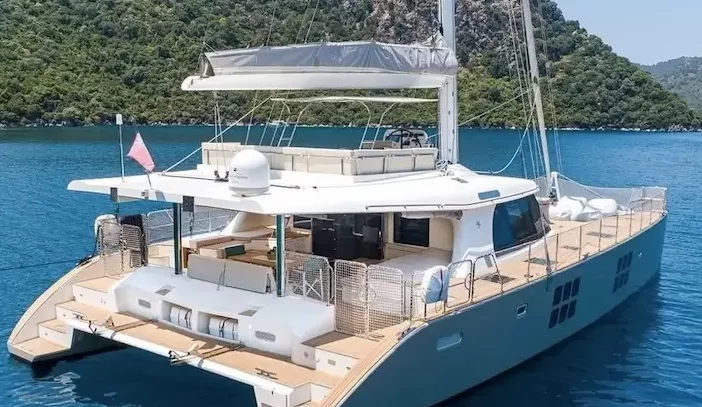Catamarans, with their distinctive twin-hull design, have become increasingly popular in both recreational and commercial boating. Their unique structure offers advantages in stability, speed, and space. This article delves into the visual characteristics of catamarans, providing a comprehensive understanding of their design and functionality.
What is a Catamaran?
A catamaran is a type of multihull vessel featuring two parallel hulls of equal size. This design contrasts with traditional monohull boats, which have a single hull. The dual-hull configuration provides enhanced stability and efficiency, making catamarans a preferred choice for various maritime activities.
The concept of the catamaran originated with the Austronesian peoples, who used these vessels to navigate the vast expanses of the Indian and Pacific Oceans. Their innovative design allowed for efficient travel and exploration, laying the foundation for modern catamaran designs.
Key Visual Characteristics of Catamarans
Twin Hulls
The most defining feature of a catamaran is its two parallel hulls. These hulls are typically slender and identical in size, connected by a deck or bridging structure. This configuration not only provides stability but also reduces hydrodynamic resistance, allowing for smoother and faster movement through the water.
Bridgedeck and Trampoline
Between the two hulls lies the bridgedeck, which can vary in design based on the catamaran’s purpose:
- Recreational Catamarans: Often equipped with a trampoline—a stretched fabric or netting—that serves as a lounging area and facilitates water drainage. This feature is common in beachcat designs, such as the Hobie Cat.
- Cruising Catamarans: Feature a solid bridgedeck that houses cabins, salons, and other amenities, providing comfortable living spaces for longer voyages.
Beam Width
Catamarans are known for their wide beam (the width of the vessel), which contributes to their stability. The distance between the two hulls allows for a spacious deck area, enhancing both functionality and comfort. For instance, the Hemisphere yacht boasts a beam of 54.5 feet, providing ample space for luxurious accommodations.
Sail and Mast Configuration
Sailing catamarans typically feature:
- Single or Multiple Masts: Depending on the design and size, catamarans may have one or more masts. For example, the Hobie 14 is a single-mast design, while larger models may incorporate additional masts.
- Sail Plans: These can vary from simple setups, like the sloop rig (one mast with a mainsail and jib), to more complex configurations, depending on the vessel’s intended use and size.
Hull Shape and Design
The hulls of a catamaran are usually narrow and streamlined, designed to minimize drag and maximize speed. Some modern designs incorporate wave-piercing bows, which allow the vessel to cut through waves more efficiently, enhancing performance in various sea conditions.
Variations in Catamaran Designs
Catamarans come in various designs, each tailored to specific functions and preferences:
Beachcats
These are small, beachable catamarans, typically ranging from 14 to 20 feet in length. They are designed for easy launching from the beach and are popular for recreational sailing. A notable example is the Hobie 16, introduced in 1969, which became one of the most popular catamarans ever built.
Cruising Catamarans
Larger catamarans designed for extended voyages offer ample living space, including cabins, kitchens, and lounges. Their wide beam provides stability and comfort, making them ideal for long-distance sailing and liveaboard lifestyles.
Racing Catamarans
Built for speed and agility, racing catamarans utilize lightweight materials and advanced hull designs. They often feature larger sail areas and are optimized for performance, participating in competitive sailing events worldwide.
Advantages of Catamaran Design
The unique design of catamarans offers several benefits:
- Stability: The wide stance of the twin hulls provides exceptional stability, reducing the likelihood of capsizing and offering a smoother ride, even in choppy waters.
- Shallow Draft: Catamarans typically have a shallower draft compared to monohulls, allowing them to navigate in shallow waters and access areas inaccessible to deeper-draft vessels.
- Speed and Efficiency: The reduced hydrodynamic resistance due to the slender hulls enables catamarans to achieve higher speeds with less power, making them fuel-efficient and faster under sail.
Considerations and Limitations
While catamarans offer numerous advantages, there are certain considerations to keep in mind:
- Mooring and Docking: The wide beam can make finding suitable docking spaces challenging and may incur higher mooring fees.
- Handling Characteristics: Catamarans handle differently than monohulls, particularly in terms of tacking and maneuvering, which may require additional skills and experience.
- Load Sensitivity: Catamarans can be more sensitive to weight distribution, and overloading can affect performance and stability.
Conclusion
Catamarans are distinctive vessels characterized by their twin-hull design, offering unparalleled stability, speed, and spaciousness. From small beachcats to luxurious cruising models, their unique appearance and functionality have made them a popular choice among sailors and boating enthusiasts worldwide. Understanding their visual characteristics and design principles provides insight into why catamarans stand out in the maritime world.

